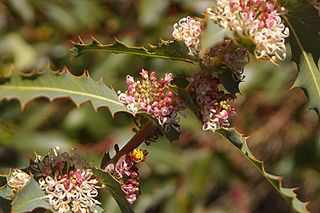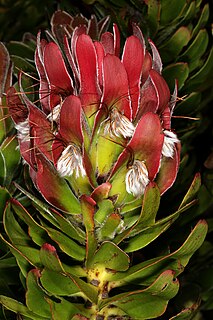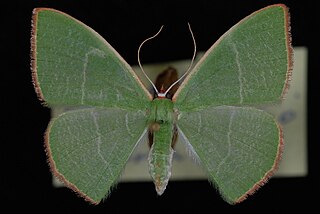
Banksia aurantia, commonly known as the orange dryandra, is a shrub that is endemic to Western Australia. It has underground stems, deeply divided leaves with 18 to 28 lobes on each sides, about eighty pale orange-pink flowers in each inflorescence, and egg-shaped follicles.
Banksia lepidorhiza is a species of prostrate shrub that is endemic to Western Australia. It has underground stems, linear pinnatipartite leaves with sharply pointed lobes, pink, cream-coloured and yellow flowers in head of about thirty and egg-shaped follicles. It is only known from near Woodanilling.
Banksia pallida is a species of column-shaped shrub that is endemic to the south-west of Western Australia. It has densely hairy stems, linear leaves with three to five serrations on each side, pale yellow flowers in heads of up to eighty and egg-shaped to elliptical follicles.
†Helenoconcha leptalea is an extinct species of small air-breathing land snails, terrestrial pulmonate gastropod mollusks in the family Charopidae.

Mimetes cucullatus is an evergreen shrub with several, mostly not branching, upright stems of 1–2 m (3–7 ft) high, that has been assigned to the family Proteaceae. It is the most widespread and most common pagoda species that can cope with a relatively large range of environmental circumstances. It is known under several names including common pagoda in English and rooistompie in Afrikaans.
This glossary of botanical terms is a list of definitions of terms and concepts relevant to botany and plants in general. Terms of plant morphology are included here as well as at the more specific Glossary of plant morphology and Glossary of leaf morphology. For other related terms, see Glossary of phytopathology and List of Latin and Greek words commonly used in systematic names.

Hakea amplexicaulis, commonly known as prickly hakea, is a shrub endemic to south west Western Australia. An attractive small shrub with unusual stem clasping, sharply serrated foliage and a profusion of sweetly scented variable coloured flowers from late winter to spring.

Carex leptalea is a species of sedge known by the common names bristly-stalked sedge and flaccid sedge. It is native to much of North America including most of Canada, the Dominican Republic, and the United States. It only grows in wetlands. This sedge produces dense clusters of thin stems up to 70 centimeters tall from a network of branching rhizomes. The thin, deep green leaves are soft, hairless, and sometimes drooping. The inflorescence is up to 16 millimeters long but only 2 to 3 millimeters wide, and is yellow-green in color. There are only a few perigynia on each spikelet, and they are green and veined.
- Carex leptalea subsp. harperi(Fernald) W.Stone - southeastern US from Texas and Florida north to Missouri and Pennsylvania
- Carex leptalea subsp. leptalea - widespread from Alaska east to Nunavut and south to California and Dominican Republic
- Carex leptalea subsp. pacificaCalder & Roy L.Taylor - Washington State, British Columbia, southeastern Alaska
Cocculina leptalea is a species of sea snail, deep-sea limpet, a marine gastropod mollusk in the family Cocculinidae.

Choristella leptalea is a species of sea snail, a marine gastropod mollusk in the family Choristellidae.
Copulabyssia leptalea is a species of sea snail, a marine gastropod mollusk in the family Pseudococculinidae.

Choristella is a genus of sea snails, marine gastropod mollusks in the family Choristellidae.
Onoba leptalea is a species of minute sea snail, a marine gastropod mollusk or micromollusk in the family Rissoidae.

Mimetes fimbriifolius, also called cowl pagoda or the fringed pagoda, is a species of plant in the family Proteaceae. It is a dense, rounded, multi-branched tree that grows up to 4 metres in height. This attractive and striking plant flowers all year round, and produces red and yellow branch-heads and inflorescences. The nectar-rich flowers are pollinated by sunbirds and the seeds are distributed and taken underground by ants before germinating. It is endemic to the Table Mountain range in the city of Cape Town, South Africa.
Acacia leptalea, commonly known as Chinocup wattle, is a shrub belonging to the genus Acacia and the subgenus Phyllodineae that is endemic to a small area in south western Australia. It is listed as threatened according to the Environment Protection and Biodiversity Conservation Act 1999.

Nemoria leptalea is a species of emerald moth in the family Geometridae. It is found in Central America and North America.
Leucospermum profugum, the Piketberg pincushion, is a species of evergreen shrub in the family Proteaceae. It is an endangered species, only known from three close locations in the Western Cape province of South Africa. It has hairless and leathery inverted lance-shaped to oblong leaves tipped with mostly three or four teeth and flattened egg-shaped flowerheads of 9–12 cm (3.5–4.7 in) in diameter, that consist of initially yellowish-orange flowers that later change to salmon pink. From the center of the flowers emerge almost straight styles that jointly give the impression of a pincushion. Flower heads can be found between late September and December.

Leucospermum pedunculatum is an evergreen, low shrub of 15–30 cm (5.9–11.8 in) high spreading from a single stern upright stem, from the family Proteaceae. The powdered or hairless line-shaped to somewhat sickle-shaped leaves are 3–6 cm (1.2–2.4 in) long and 2–5 mm (0.08–0.20 in) wide. The stalked, individually set flower heads are globe-shaped, 2½−3 cm in diameter consist of initially white to pale cream flowers that eventually turn carmine. From the center of the flowers emerge straight styles that jointly give the impression of a pincushion. It is called white-trailing pincushion in English. It flowers from August to January, peaking in September. It is an endemic species that is restricted to a narrow strip on the south coast of the Western Cape province of South Africa.

Leucospermum saxatile is an evergreen, rising to sprawling shrub of ½–¾ m high and 1–1½ m (3⅓–5 ft) wide, from the family Proteaceae. It has reddish tinged flowering stems and line-shaped, narrowing wedge-shaped leaves of 2½–5 cm(1–2 in) long and 2–5 mm (0.08–0.20 in) wide, with one to three blunt teeth, whorl-shaped, flat-topped, at first pale lime green but later carmine flower heads of 2½–3 cm across, mostly individually but sometimes grouped with two or three, each on a stalk. The flower heads occur from July to October. From the flowers occur long styles with a slightly thicker tip, which together give the impression of a pincushion. It is called Karoo pincushion in English. Flowering heads can be found from July until February. It naturally occurs in fynbos in the Western Cape province of South Africa.

Acacia menzelii, commonly known as Tallebung wattle or Menzel's wattle, is a shrub belonging to the genus Acacia and the subgenus Plurinerves native to a small area of southern Australia.










